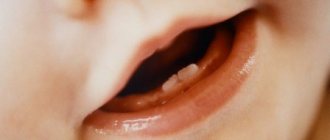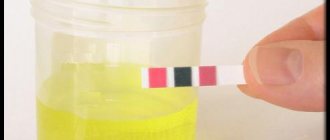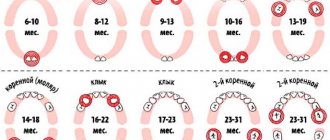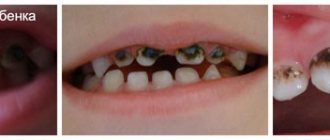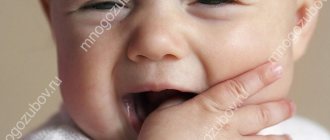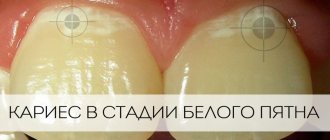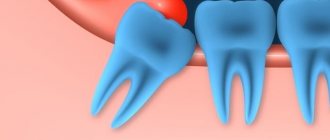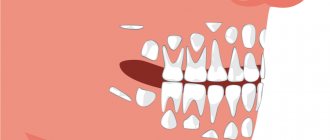Changing children's baby teeth to permanent ones is always an exciting time for parents. This process is quite lengthy and often painful for the child, because it can be accompanied by various inflammations and discomfort. To help parents, for a better understanding of the physiological processes associated with the formation of teeth, dentists offer to look at the pattern of loss of baby teeth in children.
Bookmarking teeth
The formation of baby teeth occurs at approximately 4-6 weeks of fetal development. At the same time, the formation of the fundamental elements occurs much later - during the first months of the child’s life. For this reason, new mothers who are bottle-feeding are strongly recommended to supplement their baby’s diet with calcium. This substance promotes the proper formation of tooth enamel.
At an early age, unprotected baby teeth are extremely susceptible to carious lesions. Parents should monitor this closely, as infection can subsequently cause destruction of permanent teeth. The fact is that the rudiments of permanent teeth are in close proximity to the roots of milk teeth, so as soon as you discover dark spots on your child’s enamel, immediately go to pediatric dentistry.
Is there always a change?
Not a single child's tooth should be preserved - they all fall out. Instead of each temporary one, a permanent one is cut through. But it also occurs in dental practice that the rudiment of the root unit is missing. This can be seen in the X-ray of the jaws.
In this case, the life of the baby tooth is extended to the maximum - after all, nothing will grow in its place. When an empty space appears in the dentition, the issue of prosthetics is discussed.
To eliminate partial congenital edentia, you can implant an implant or install a dental bridge. In the first case, there is no need to file adjacent teeth. The doctor, under local anesthesia, installs an artificial titanium root into the jaw tissue. When it takes root, it fixes the dental crown.
In the case of a bridge, it is necessary to depulpate and prepare the neighbors . This is not very healthy, since their service life after such manipulations is significantly reduced. Therefore, young patients who do not have separate molars are recommended by dentists to resort to implantation.
Baby teeth in children: loss pattern
Many mothers are concerned about the question of when their children’s baby teeth begin to fall out. As a rule, this process starts immediately before primary school, that is, at the age of 6-7 years. In this case, the pattern of loss of baby teeth in children is similar to the sequence of their eruption. Only the fangs differ, which are replaced later, by the age of 13.
The order in which baby teeth fall out is the same for almost all children. First, molars grow - molars, which were absent in the “milk” set. As soon as there is enough space in the child’s jaw, “sixes” begin to appear. Only after this comes the time to change temporary teeth.
First, the lower incisors fall out, and then the upper ones. After this, the premolars appear at about 9-11 years of age. The last in line are the fangs, which usually fall out by the age of 10-12 years. At the same time, there should already be molars in the child’s mouth. After 18 years, third molars or, as we used to call them, wisdom teeth begin to emerge. However, they do not appear in everyone, which, by the way, does not indicate the presence of any pathologies.
The permanent crown did not appear
Long-term absence of permanent teeth can be caused by two reasons:
- Retention. It is characterized by slow eruption of the crown due to prolonged development of the rudiment or its incorrect position, for example, deep burial.
Retention can be either complete or partial. Partial is characterized by incomplete eruption, when the coronal part only appears slightly in the gum and stops growing.
These pathologies can be caused by certain factors:
Stimulation
In case of late tooth eruption, specialists prescribe special stimulating therapy. Standard stimulation therapy includes the following methods:
- Applying applications. To do this, use a ready-made 0.05% solution of humic acid obtained by isolating low-mineralized type sulfide silt mud.
The solution is prepared on the basis of isotonic sodium chloride. A tampon is soaked in the drug and applied to problem areas for an average of 5 minutes. The procedure is carried out for 15 days and no more.
This drug has a powerful biostimulating effect by improving tissue respiration, normalizing metabolic processes and sedimentation of minerals necessary for crown development.
In addition, the product leads to slight loosening of the bone area in the area where the rudiment is located, which facilitates its formation and eruption. Irritating removable dentures. It is a structure that looks like a bridge. But, unlike it, in an irritating prosthesis the main supporting part is located not on the adjacent teeth, but on the gum.
Due to constant pressure on the area of the jaw with an impacted rudiment, trophic processes are improved and its growth is stimulated. The period of wearing the prosthesis will depend on each specific case. Gum tissue massage. Aimed at regulating metabolic processes and saturating tissues with minerals. As a rule, massage is done 1-2 times a day until a positive result appears or for at least 8 months.
A set of exercises is selected by the doctor depending on the patient’s age and the area of the tooth. Physiotherapeutic procedures. The most effective in this case was electrophoresis performed using adrenaline or lidase. Both drugs have the same pronounced stimulating effect, but their therapeutic effects are completely different.
Read also: How long does the temperature last during teething?
Adrenaline is a hormonal drug whose action is aimed at stimulating the natural process of teething.
Unlike lidase, it gives a faster and more predictable result, but can cause a disorder in the hormonal balance of the child’s body, which will entail negative changes in terms of general health.
The main action of lidase is aimed at loosening the bone area in the area of the bud, which facilitates the process of its eruption.
This drug also has its disadvantages: such exposure can lead to disruption of the mineral balance of the dental tissue of the developing tooth and adjacent crowns. The drug Honsurid. Aimed at restoring the functions of the embryo and improving metabolism in bone and cartilage tissues. The drug is used externally, diluting it with novocaine or sodium chloride.
For a stimulating effect, the drug is used to treat the mucous membrane in the area of the supposed root of the problem area. The procedure can be carried out once every 2 days for 10 days.
In some cases, the course can be extended to 1 month.
Survey
Despite the existence of average periods for the eruption of permanent teeth, they are individual for each child.
A discrepancy of one or two years is quite acceptable.
But if eruption has not begun even 4 years after the loss of milk crowns, then this is a direct indication for a detailed examination. The following methods are used for this:
- visual examination – allows you to determine the general condition of the oral cavity;
- palpation and instrumental examination will show the degree of density of the gum tissue;
- intraoral targeted radiography. Performed to obtain accurate data on the position of the bud;
- orthopantomography – helps to see the condition of the embryo and its tissues;
- CT scan allows layer-by-layer examination of the tissues of the bud and the surrounding bone.
Diseases
During the examination, the following diseases are most often detected:
- rickets or rickets-like condition. It occurs due to a constant lack of bone-forming minerals due to a pathological condition. To resolve the problem, it is necessary to undergo long-term treatment with the inclusion of drugs with a high content of minerals and vitamins;
- pathologies of the endocrine system. Most often, the cause is hypothyroidism suffered in the first year of a child’s life. Treatment requires the use of hormonal drugs, both local and general;
- infectious diseases of a chronic type , for example, tonsillitis. As a rule, in the presence of such pathologies, it is necessary to carry out complex treatment aimed both at eliminating the disease itself and at increasing the immune functions of the body;
- acute respiratory diseases , which occurred at the beginning of the growth of permanent crowns. A problem of this nature should be addressed by a dentist together with a therapist.
Prevention of malocclusion
The timeliness of replacing baby teeth with permanent ones is important, since the correct development of the child’s bite depends on this. To ensure the normal formation of the dentition, it is necessary to follow a number of important rules:
- parents need to monitor the quality of their child’s oral hygiene , since children’s enamel is most susceptible to caries, and this can provoke premature loss of the crown;
- The child's diet should be as balanced as possible . It should not contain large quantities of foods containing fast carbohydrates. The menu should include foods rich in microelements and vitamins ;
- You should not avoid routine visits to the dentist. This will help prevent the development of dental pathologies and reduce the likelihood of retention;
- to take the child to an orthodontist or dental therapist as soon as possible .
Even more information about baby teeth in the video from Dr. Komarovsky:
What should parents do?
The process of changing teeth in children worries parents, but this is quite natural, and most children do not experience significant pain. However, this does not relieve parents of the need to constantly monitor the condition of their child’s oral cavity. There is no need to remove baby teeth yourself. When the time comes to say goodbye to a tooth, a certain mechanism is activated in the child’s body that dissolves the milk tooth roots. You should seek help from a specialist only if the baby tooth does not want to fall out, but the permanent one is already beginning to appear.
After a tooth falls out, you may experience some bleeding. If desired, have your child rinse his mouth with a solution of soda with a drop of iodine as a preventative measure.
If you have a problem similar to that described in this article, be sure to contact our specialists. Don't diagnose yourself!
Why you should call us now:
- We will answer all your questions in 3 minutes
- Free consultation
- The average work experience of doctors is 12 years
- Convenient location of clinics
Single contact phone number: +7
Make an appointment
When does radiography come to the rescue?
Very rarely, but still situations occur in dental practice when even the doctor doubts which tooth he has to work with - a child’s or a molar. In this case, the capabilities of radiography are used. In the photographs you can see:
- length and structural features of the roots;
- presence/absence of radical primordia;
- the location of the unerupted unit and the direction of growth of its incisal edge.
If you need to find out exactly what the situation is with a change in bite in a child, contact your dentist. He will tell you the number of units that should fall out in the near future, and tell you whether it is worth interfering with this process.
How many baby teeth do children lose?
The very first teeth appear between the ages of six months and one year. First, the incisors appear, located below and in the center, then the upper ones, and only then the lower lateral and upper lateral ones. This is followed by the first molars, canines and second molars. In pediatric practice, such a concept as a dental formula is used, that is, a standard dental set for children: 2 incisors, 2 molars and a canine. Multiplying the data obtained by four, we get 20 – the number of baby teeth is normal. Accordingly, the same number of baby teeth fall out.
Dental clinic "32 Dent" offers a full range of services in the field of pediatric dentistry. To receive complete and detailed answers to all your questions, call the numbers listed on the website.
